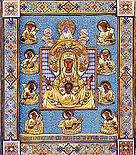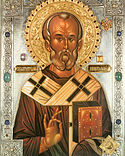27 November/10 December: Feast day of the Hodigitria (Indicator of the Way) of the Russian Diaspora, the Kursk-Root Icon of the Most Holy Mother of God
The Kursk-Root Icon of the Most Holy Mother of God is one of the oldest and best-known holy objects of Ancient Russia. This icon appeared miraculously in the XIII century at the root of a tree near the Tuskary river in the Kursk region of central Russia. A healing spring appeared and continues to flow to this day on the site where the icon was discovered. During the XIV century this area was razed by Tartar hordes. They axed the icon in half and it was lost for many years. The icon was found a second time near the site of its original appearance, and miraculously the two halves of the icon grew together. Since then, for over eight centuries, there has been a constant outpouring of miracles from this holy image: healings from all sorts of illnesses, deliverance from all sorts of evils—fire, war, bombardment, consolation of the most profound sorrows, and the of granting the gift of faith to the godless and blaspheming. This same image healed the gravely ill child of a family of Kursk merchants and builders, Prokhor Moshnin, the future st. Seraphim of Sarov, the humblest little servant of the Mother of God, as he called himself. And the great luminary of our times, St. John of Shanghai, reposed before this icon, bent in prayer, prostrated before it on the floor.
The Kursk-Root icon is the holiest treasure of the Russian Orthodox Church Abroad. It is remembered in our history as the “Hodigitria”, or “Indicator of the Way” for the Russian emigration, and bore witness to the special protection and guidance of the Mother of God for Russian exiles. This holy icon left Kursk several times throughout Russian history: at the request of tsars and emperors, to strengthen and support Russian Orthodox soldiers at times of war, or during pestilence and epidemics. But the icon always returned to Kursk, and there were several cases when no human effort could move the icon from its place, or when it would miraculously return home of its own accord. Nevertheless, in 1920 the Most Holy Mother of God deigned to move her holy image not only out from Kursk, but even abroad, out of a Russia that had been overcome by the Bolsheviks. The icon left with that part of the Russian church that refused to compromise or collaborate with the godless authorities. Not long before the revolution the godless had attempted to destroy this holy image, planting a bomb beneath it on the Sunday of the Cross in 1898. That night a huge explosion wreaked havoc in the Kursk cathedral and warped the iron canopy that housed the icon, while the image itself remained completely unharmed. As a result, the explosion glorified the Mother of God still more greatly, and served to strengthen the faith of the Orthodox, rather than to disillusion or discourage them. The Bolshevik secret police managed to steal the icon in 1918, but it was soon recovered. When the White army was forced to retreat from Kursk, Archbishop Theophan, diocesan bishop of the Kursk region, and several of the brethren of the Kursk monastery dedicated to the icon, desiring to preserve it from further harm and possible destruction, traveled with the image to the south of Russia, then to the Crimea and on to Serbia. Here the Synod of the Russian Orthodox Church Abroad was able to gather around this image, under the protection of the Most Holy Mother of God.
The Kursk-Root icon lived through all of the trials of the first decades of exile together with the Russian diaspora, and then through the horrors of the Second World War, preserving thousands of Russians and Serbs when Belgrade and Berlin were bombed. The icon came to America, to New York, in 1951, together with Met. Anastasy (Gribanovsky). Over the subsequent years this miracle working icon visited every corner of the earth where the Russian diaspora had settled, consoling and strengthening the faithful, constantly working miracles, healing and transfiguring many souls. By the unfathomable providence of God today this miraculous image remains with that part of the Russian Orthodox Church Abroad that recognized the Moscow Patriarchate. Let us beseech the Most Holy Mother of God to strengthen us in our spiritual struggle to preserve the testaments and traditions of the Russian Orthodox Church Abroad, and that we might remain on the path that She Herself, our Hodigitria, indicated. Let us beg Her not to forget nor desert us, and if we are found worthy of it, She can restore the icon of the Hodigotria to us.
It was the tradition in the Church Abroad to celebrate the feast of this holy icon twice a year: on the feast of the Nativity of the Most Holy Mother of God in September, when the main solemnities were celebrated at the New Hermitage of the Kursk-Root Icon in Mahopac, NY, and on December 10th, at the ROCOR Cathedral dedicated to this icon in Manhattan. In spite of the fame and the great veneration for this icon throughout Imperial Russia, a special service was never composed in its honor. The service and Akathist used by the Church Abroad were composed in the late 20’s or during the 30’s of the past century by Valeria Konstantinovna Hecke, the well-known hymnographer and composer of liturgical texts of the Russian Orthodox Church Abroad
(https://novisrbljak.livejournal.com/37416.html, http://novisrbljak.narod.ru/PDF_files/Izdrizv/Kursko_korena_ikona_PB.pdf (in Slavonic) and approved by Met. Anthony (Khrapovitsky_ and the Synod of the Russian Orthodox Church Abroad. This was Valeria Konstantinovna’s first work, she went on to write over twenty liturgical services. Including the ROCOR service for St. Blessed Xenia. The liturgical service in honor of the Kursk-Root icon glorifies and honors the Most Holy Mother of God and also mentions concrete historical events: the healing of st. Seraphim, the Russian revolutionaries’ attempt to blow up the icon, etc.
Many of these texts were first set to music by famous émigré composer and conductor of the Synod Cathedral choir, Boris Mikhailovitch Ledkovsky. This work was completed and published by his son, Alexander Borisovitch in 2003. (http://www.rocm.org/scores/feasts/ServiceKurskIcon.pdf, http://www.rocm.org/scores/feasts/LedkovskyA-ExapostilarionKurskIcon.pdf )

